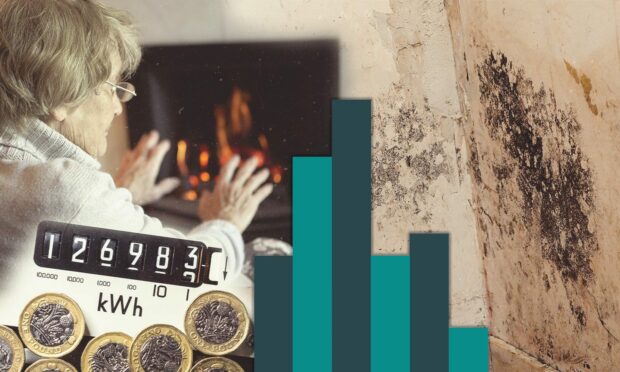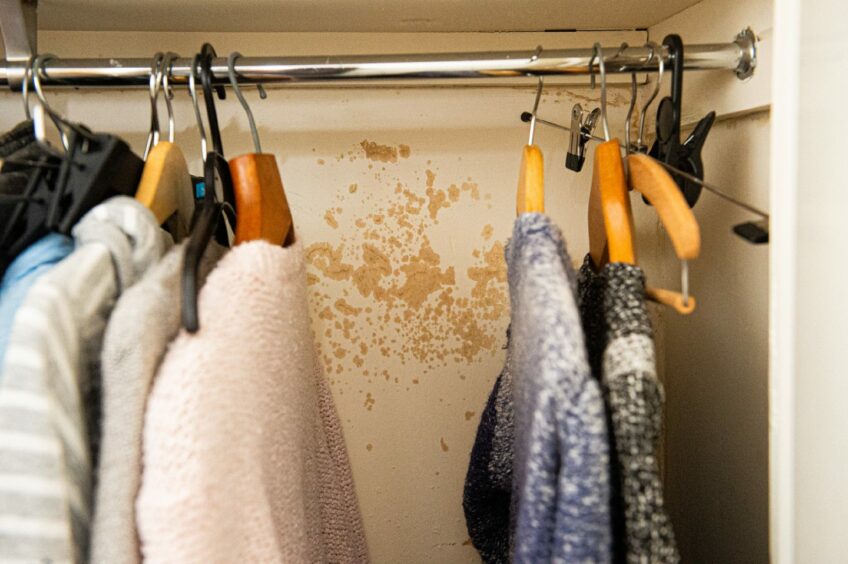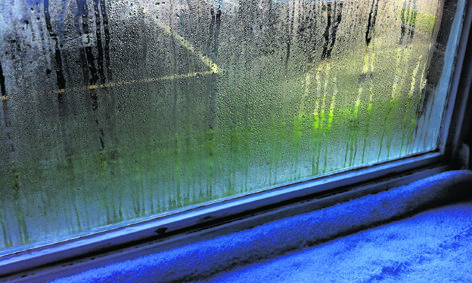With the colder months away to draw in and the cost-of-living crisis squeezing households to the brink, many may be worried about heating their homes.
An issue that may not be top of the agenda for those struggling could be mould and damp.
But, as people begin to stay indoors more and keep windows closed for fear of losing heat, moisture will begin to build up inside the home.
According to the NHS, mould produces allergens, irritants and sometimes toxic substances.
The health service warns a damp and mouldy home can lead to respiratory problems and infections, allergies or asthma.
As well as proper ventilation, heating and maintaining temperatures in every room can also help to reduce mould and damp in homes.
For some, this may not be possible this winter.
New figures obtained by The P&J through a series of freedom of information (FOI) requests revealed mould and damp have consistently been issues faced by those living in social housing across the north and north-east.
The statistics from Aberdeen City and Aberdeenshire are contrasting but highlight the issue nonetheless.
Aberdeen City Council failed to investigate every report
Since 2016, Aberdeen City Council received 122 complaints from their tenants about mould and damp.
During those six years, investigators were sent to deal with 91 of those complaints – meaning 31 homes were left dealing with the issue.
After we shared Jacqueline’s story, more people living in Aberdeen City Council social homes reached out to share their experiences, such as a family who were handed keys to a new home riddled with mould.
Or the instance where Nicole Kruschak’s ceiling collapsed in the room where she sleeps after months of complaining about the issue.
Although the council consistently failed to investigate every complaint made by tenants, each time a home was inspected repairs were made to the property.
An Aberdeen City Council spokesman said: “The welfare of our tenants is our main priority and this is reflected in the investigations we have undertaken and the resolutions we have achieved on this particular issue.
“To put the matter in perspective, we have responsibility for over 22,000 council homes across the city and the figures represent a tiny percentage of our housing stock.
“There are a variety of reasons for those instances where on-site investigations were not undertaken including an on-site investigation not being required.
“If any of our tenants do have any issues with their home we encourage our tenants to report this to us so we can look into the matter as a matter of urgency ”.
Over 2,500 reports made to Aberdeenshire Council
The FOI reveals the number of complaints was much higher in Aberdeenshire than in Aberdeen City.
Since 2016, Aberdeenshire Council received 2,535 reports of mould and damp from tenants.
While the local authority managed to address every single complaint in 2016, the number of complaints fluctuated while the proportion left uninvestigated has steadily rose each year.
Between 2017 and 2020 the number of complaints consistently decreased, while more homes were uninvestigated.
The number shot up in 2021, to 448 complaints across the area and the highest proportion of issues not investigated.
An Aberdeenshire Council spokesman said when an issue is reported the council aims to carry out an inspection to determine the cause and see if a repair is needed.
He said: “In many cases, mould and damp issues can be resolved by giving advice and information. Drying clothes indoors without proper ventilation can lead to issues, for example. We also refer tenants to Scarf for independent support and advice.
“The pandemic made it more challenging to carry out physical inspections but we continued to provide emergency repairs, and carried out remote inspections where that was possible.
“On a wider note, our programme of improvements to homes across Aberdeenshire continues.”
Is mould and damp an issue in social homes elsewhere?
The problem is not just confined to social homes across Aberdeen City and Aberdeenshire.
Highland Council has also failed to investigate every complaint of mould and damp from tenants. In 2021, the local authority received 38 reports and only investigated four of these.
Meanwhile, Orkney Council had 19 complaints in 2021 and investigated all of them in the same year.
Shetland Council received no complaints last year, but still carried out 21 investigations in their social homes. In fact, since 2016 the local authority had five complaints from tenants but carried out 230 investigations anyway.
Moray Council could not provide the number of investigations carried out. However, in 2021 there were 15 complaints and 109 repairs carried out – much like Shetland, Moray Council carried out more repairs over the years than they received complaints.
Furthermore, Edinburgh City Council had 730 reports of damp and mould in their social homes, and also investigated each issue.
If you have experienced any problems with mould or damp in your social home, let us know about it in the comment section below.
North and north-east households worst prepared for winter
Social tenants in the north and north-east are facing tough conditions this winter as pre-existing fuel poverty collides with record-breaking energy bills.
A significant number of households in Scotland could struggle to cope with the upcoming energy fuel cap increase, which the latest consultancy estimates predict could hike household bills up 81% in October.
The most recent review of housing conditions shows social tenants across Aberdeen, Aberdeenshire, Moray, Highland and the Islands could be worse prepared for these challenges as they already experience high levels of fuel poverty.
This is especially stark in the Western Isles where more than two-thirds of social tenants were estimated to be in fuel poverty – the highest in the whole of Scotland.
Are the councils preparing for fuel poverty?
The Aberdeen City Council spokesman explained damp and mould is commonly caused through condensation.
He said: “It is advised that to avoid condensation, steps should be taken such as temperatures within homes being kept consistent, increase ventilation, avoid placing furniture against an external wall, and try to avoid drying clothes inside where possible.”
The local authority is setting up an anti-poverty committee in response to the cost-of-living crisis.
The committee, with councillor Christian Allard as covener, will begin assessing how best to help people.
Mr Allard said: “Because we are at the height of summer it would be better to hold on until bills come in October to see what kind of winter we’re going to have.
“We’re all bracing ourselves for a deluge of people who are going to struggle very much. It’s what we’re going to concentrate on as a city, as a council and under the anti-poverty committee.”
The Aberdeenshire Council spokesman stressed the council has “significantly” increased support to those experiencing fuel poverty, while Scarf’s Home Energy Advice Team can help people access support.
The council will provide food and fuel vouchers to vulnerable tenants, and advisors will try to find long-term solutions for households. There is also support available to help people reduce their energy bills.
He said: “Aberdeenshire Council also remains committed to a wide-ranging programme of energy efficiency improvements to help our tenants reduce running costs, carbon emissions and the energy used in our council houses and flats.
“As part of that improvement works plan we are installing cavity wall, internal and external wall and loft insulation and also installing highly efficient ‘A’ rated windows.
“The programme also includes the installation of renewable energy systems such as solar photovoltaic roof panels for generating electricity and batteries to store this energy.”
‘Nobody should be expected to live in those conditions’
One of the ways Shelter suggests to prevent mould and damp issues in the home is to heat every room to a low temperature of at least 15C.
The housing charity advises covering pans as well as closing doors when cooking or showering and using extractor fans in the bathroom and kitchen.
It also suggests opening bedroom windows for five to 10 minutes in the morning and drying clothes outside or using a tumble dryer where possible.
Director of Shelter Scotland Alison Watson said: “Everyone has the right to live in a warm, safe, comfortable home. That applies to people in social housing in exactly the same way as those living in other tenure types.
“Mouldy, damp homes can have a devastating effect on both physical and mental health; nobody should be expected to live in those conditions.
“We would encourage anyone suffering from mould or damp in their home to visit the Shelter Scotland website or get in touch for guidance and support.
“We are in a housing emergency and building more good quality social homes is the only way out.
“The Scottish Government needs to significantly increase the supply of social homes, while also ensuring all existing homes are fit for purpose.”
Initiatives helping communities struggling with rising energy bills:





Conversation